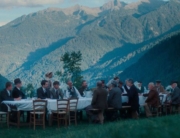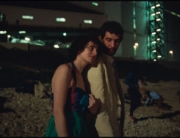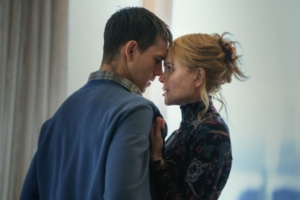The most desolate and hopeless setting outside of dystopian fiction can be found in Matteo Garrone’s new film, which was shot on location in the seaside town of Castel Volturno, not far from Naples. (It was profiled in a New York Times article with the spot-on title, “Forsaken Village on Italy’s Coast Tells Tale of a Paradise Lost.”) Storefronts are boarded up, and what passes as a playground is a dirt patch surrounded by concrete apartment buildings that sprouted in the 1950s and ’60s and now look like the set of a ghost town. The location is a central character and permeates the entire film.
The screenplay, freely inspired by a real-life incident, relentlessly pits a slightly built, quiet dog groomer, Marcello (the remarkable Marcello Fonte), against the town’s brute, the innocuously named Simoncino (Edoardo Pesce), a hulk who is into cocaine and terrorizing his neighbors. He owes all of the local drug dealers money, so he coaxes the least likely person to resist his demand to buy the drugs for him: Marcello, who’s easy pickings. With his large eyes, big ears, and heavy eyelids and spry physicality, he has the look of a sad clown. The beefy Simoncino, though, towers over him, and there is always the implied threat of violence; he has been in his fair share of fights, as evidenced by his broken nose. He’s out of control the moment he’s introduced onscreen—he even gets in a fight with a video arcade machine and comes out the winner. Besides using Marcello for scoring coke, he physically drags him away from his home and into the night to stand watch during a robbery.
Garrone takes the monstrous versus the meek scenario and adds layers to Marcello, making the movie compelling and appropriately frustrating. He has created a victim who, in many ways, abets in his own degradation. The soft-spoken groomer is not quite a babe in the woods. He helps himself to stolen goods, and he has more than one opportunity to break away from Simoncino, and yet there are enough indications that he may enjoy the thug’s company, to a point, or at least the companionship of someone who doesn’t have four legs. However, in Marcello’s domain, his grooming shop, he reigns with a magic touch with pooches big and small and of all temperaments. Yet even when he goes out of his way to willingly lend Simoncino a helping hand, there is no reciprocation. Every good favor is squashed.
The story line takes a break from bleakness when Marcello, a divorced dad, takes his daughter (“daddy’s beautiful girl”) scuba diving in Calabria. Only the underwater sequences feature a musical score, as though to calm the viewers’ nerves as the violence and the exploitation of Marcello greatly increase. The brisk editing, the cinematography of various color palettes, and the handheld camerawork all add a vibrancy that lifts the film from the depths of miserablism.
Although this film’s focus is on a smaller scale than Garrone’s breakout film Gomorrah, the moral failures of the community are also examined under a harsh light. In the earlier film, Garrone depicts how organized crime’s tentacles have strangled all aspects of Italian life. Here, in what could be a Town Without Pity, the communal honor code is put through the test: Is it better to be perceived as a snitch or to do what’s best for the common good?
That is only one question behind Marcello’s alarming and often exasperatingly decisions to accommodate and placate the local bully. If Simoncino represents chaos let loose, then the film suggests there is no escaping his corrosive and contaminating effect. Yet viewers can be rest assured. Although there are a lot of bloody beatings, no animals were involved. It’s only man that’s called on the carpet.

















Leave A Comment